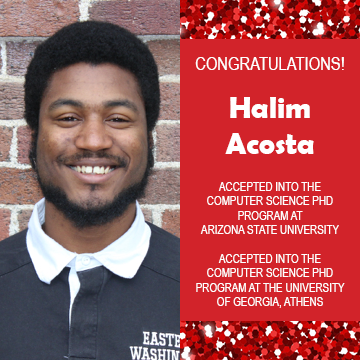Halim Acosta
Halim Acosta graduated from Eastern Washington University in 2020 with a major in Computer Science. He was selected as an EWU McNair Scholar in March of 2018 and completed his 2019 summer research Application of Space Filling Curves to The Dynamic Mobility on Demand Problem with faculty mentor Dr. Yun Tian. This research focused on an algorithm to find a solution to the ride-share problem. They worked to optimize (sub-optimal) dispatching scheme for any time instant to minimize overall travel distance and overall waiting time for a large city, such as New York. Halim has a strong interest in the fields of distributed and parallel computing. He would like to do research in the field of ubiquitous computing and more specifically the software infrastructure needed to facilitate context aware systems in highly mobile environments. He has done performance testing of the MapZen 3D terrain viewer developed by Greg Larrick of EWU’s graduate program.
Halim was accepted into Computer Science PhD programs at Arizona State University, the University of Georgia, Athens, and North Carolina State University where he began attending in Fall 2020 with full funding. Halim received his MS in Computer Science in 2023, and continues to pursue his PhD.
2019 McNair Faculty Research Mentor: Dr. Yun Tian
Research Title: Application of Space Filling Curves to The Dynamic Mobility on Demand Problem
Abstract: Ride-sharing (also called Car-pooling), by having more people using one vehicle, may reduce each person’s travel costs such as fuel, tolls, and the stress of driving. Ride-sharing is also a more environmentally friendly and sustainable way to travel as sharing journeys reduces air pollution, carbon emissions, traffic congestion, and the need for parking spaces. A ride-sharing system dynamically optimizes the process of dispatching riding providers to serve a set of riding requests, in attempt to minimize parameters, such as overall travel distance waiting time, for a large geographical region. Many challenges are confronted in the current research. First, the system is stochastic since riding requests can be made at any random time instant, which forces the system to recalculate the dispatching scheme constantly once a new group of requests are made. Second, the system must find the optimal solution based on a large volume of data, including a large set of ride requests, providers, and a large volume of geographical map data. Third, the system must find the optimal solution for all providers and requests in a real-time manner. Space filling curves have the property of mapping n-dimensional data onto 1-dimension and consequently turns it into a one-dimensional problem. Given this property, we apply it to the problem of efficiently routing a fleet of vehicles to a set of requests such that we minimize the total cost of service. In this study, we find an optimized dispatching scheme for the mobility on demand problem that works to minimize overall travel distance and waiting time for a large city such as New York. To do so we explore the locality preserving properties of space filling curves and their ability to map multi-dimensional data to a single dimension. We use the existing big data set that is provided on the website of the New York city taxi public dataset to test and verify our system.

EWU McNair Scholar Halim Acosta Accepted into Two More PhD Programs




